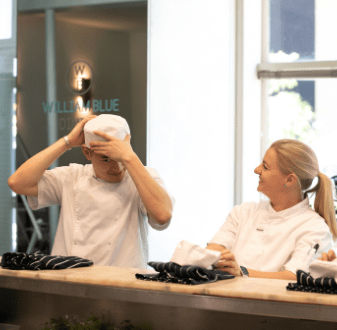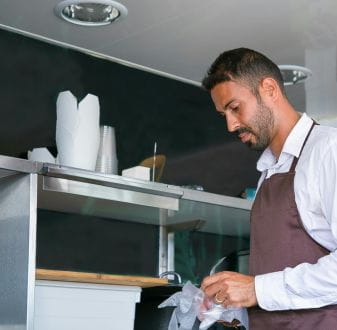If you’ve been waiting to realise your dream of opening a restaurant, now is a great time to start turning that dream into a reality. There is a lot of work to be done so let’s get started with the seven essential steps you’re going to need to take to get the doors to your restaurant open.
Firstly, just one crucial question before you read any further: do you have training or work experience in the restaurant industry?
If the answer is ‘no,’ then you need to start your journey by getting some experience in restaurants, and ideally also studying a Bachelor of Hospitality Management or equivalent.
Many new restaurant owners are passionate about their food, but you will need to equip yourself with more tools than your passion to ensure your business succeeds.
According to one recent study, between 60-80% of new restaurants fail within the first year, mainly for reasons such as choosing the wrong location, business mismanagement or bad menu planning or uncompetitive pricing. Many of these problems come down to a lack of experience and education.
Make sure you’re prepared for the challenges ahead before you get started working your way down these seven essential steps.
Write a thorough business plan
Before you do anything else, you need to conduct research and write a detailed business plan for your restaurant.
Your business plan will help you to develop a clear understanding of the market, competition, customer base, your restaurant concept, financial viability and unique selling points (USPs), plus you need to include strategies for everything from operations to marketing.
A typical restaurant business plan will include these important elements:
- Restaurant summary
- Business overview
- Industry analysis
- SWOT analysis
- Operations plan
- Financial analysis
- Marketing plan
Although the worst of the pandemic may be behind us, hygiene and risk management are also still very important considerations for a restaurant in 2022 to address in their business plan. COVID-19 aside, hygiene failures cost the food services sector in Australia approximately AUD$15 billion per year, according to a new report. Make sure your business plan this year includes a hygiene management strategy, too.
This business plan will help to guide and shape your restaurant into a success, and it will help you to find the essential investors you need to begin. The more thorough it is the better your chances of success will be. So put in all the time you need to get it right.
Finance your restaurant
Starting a restaurant can be an expensive venture. Research from Restaurant Startup and Growth magazine suggests that the average restaurant owner in Australia spends around $650,000 establishing a restaurant.
Labour and food are the biggest running costs of a restaurant, while the cost of kitchen equipment for setup can set you back anywhere between AUD$106,00 -162,000.
Of course, the type of business you are planning to run will shape your costs: a ghost kitchen or a small food truck are cheap restaurant business options compared to a large fine-dining restaurant at the other end of the price scale.
You will already have developed a budget and finance plan suitable to your business size and concept during the business planning stage. Now, you can take this plan to a bank, business investment group or private investor to finance the start-up and initial running costs of your business.
There are lots of different types of finance or business loans available to aspiring restaurateurs in Australia, including:
- Equipment finance
- Bank term loan
- Unsecured business loan
- Small business loans
Provided you have a solid business plan, some initial capital and acceptable credit history, you should not face big obstacles in obtaining a loan or finance to start your business.
Licences and permits
The service of food and alcohol is regulated in Australia according to state, so the particular type of licences you will need will depend on the location of your business. However, generally speaking, you will need to:
- Register your business with your local council.
- Get a licence to serve food from your state authority.
- Put in a development application to renovate your premises.
- Register an Australian Business Number (ABN), and Australian Company Number (ACN) with ASIC: this will involve choosing a company type. A typical restaurant or small business is commonly registered as a Pty Ltd company.
- If your business has a turnover over $75,000, register for the Goods and Services Tax (GST).
- Obtain a liquor licence if you want to sell alcohol.
- Obtain a licence to play music from OneMusic.
- You may need other permissions such as the ‘Approval for Outdoor Dining in a Public Place’ in NSW, depending on your business and location.
As you can see, the process of obtaining all the required licences can be quite involved, so make sure you set aside time to learn about all the necessary paperwork and to study your tax and reporting obligations.
Choose the right property for your business
Location is often one of the biggest factors determining whether or not a restaurant will succeed within the first year. It costs a lot of money to install a kitchen and set up a restaurant business, so it’s essential to get your location right before you start any renovations.
When you’re choosing a property for your restaurant, make sure you consider important points, such as:
- Zoning and alcohol regulations for your property
- Foot and car traffic
- Your target market and local residents
- Competition in the area
- Space turnover
- Accessibility
- Visibility
- Local area character and ambience
Ask yourself, is your restaurant a right fit for your neighbourhood in terms of pricing, product and USPs? If the answer is yes and you’ve found the right place, it’s time to start hiring.
Hire all the right staff
Good customer service and an effective team in the kitchen are essential components of any successful hospitality business. Hiring is a crucial step in setting up your restaurant, so it’s crucial to ensure you choose the right staff. Depending on the size of your operation, a restaurant will typically need:
- Chefs, cooks and kitchen staff
- Waitstaff
- Bartenders
- Restaurant manager
- Host or concierge
- Runner
- Dishwasher
- Busser
- Barista
- Sommelier or wine expert
If you are running a small restaurant or cafe, typically you will need staff who are able to work across multiple roles, such as waiting, making coffee, serving at the bar or working the cash register, depending on the requirements of the shift. A good restaurant manager should be able to multitask across marketing, payroll, rostering, hosting, expediting and front of house duties.
Hiring a team of multi-skilled, competent and flexible staff is just as essential to a restaurant as having a good chef. The food must be made, but it must also arrive on the table in a timely and friendly manner.
In addition to finding and hiring staff, you will also need to:
- Create hiring and staffing policies, contracts and procedures
- Decide on any training procedures
- Develop a rostering and payroll system
Once you have your amazing team of staff, remember to always treat them well. A high staff turnover and bad atmosphere can cost a restaurant a lot of money and customers. In fact, one study from Cornell University in the US shows that on average, restaurants lose US$106,285 per year from the costs of high staff turnover.
Prepare to open
Design everything from the interior to the menu
Every choice in your restaurant should be a conscious decision, based on unified branding and creating an exceptional customer experience. From the menu to the decor, streamline and design your restaurant with a palette, furnishings and aesthetics along your chosen theme. Don’t forget the mood lighting and maybe consider adding some design features to encourage social sharing.
Equip your kitchen and restaurant
Work with your chef to determine what equipment you’re going to need to fit out your kitchen adequately according to the menu. The selection of dinnerware and glassware is just as important, and will also depend on your menu items.
Source food and beverage suppliers
Your food and beverage suppliers are crucial to your business. Put effort into finding the right ones. The restaurant manager, owner or chef will need to develop ongoing relationships with produce vendors, butchers, fishmongers, and beverage distributors, to ensure your restaurant is adequately stocked.
Don’t forget to deliver
Between 2020 and 2022, the food delivery industry in Australia grew from a value of $718 million to $851 million, with an overall growth of 20.6% over the past five years. The data shows that consumers now expect many restaurants to provide takeaway and delivery options. Just as you build your restaurant interior, you should be building your presence on the most popular delivery apps.
Every successful restaurant business must also be prepared for busy nights with a good Point of Sale (POS) and ticketing system for chefs. Make sure you tick off this checklist before opening night, to ensure there are no hidden surprises.
Market your business
Of course, in 2022 we all know if it’s not online it doesn’t really exist. A big part of making sure your new restaurant succeeds is putting it on the map: literally, by adding it to Google Maps.
Now you’ve put all this effort into setting up a new restaurant business, you need to make sure all your potential customers know about it. Now is the time to implement the marketing strategy you wrote when you developed your business plan in step one.
Remember a few crucial points when it comes to marketing a restaurant in Australia in 2022:
- You need a beautiful and functional website with a readable menu on it.
- When it comes to food, images are the best marketing tool you have.
- A social media presence is essential in 2022.
- Online reviews can make or break a business: engage and respond.
Running a restaurant is a challenging enterprise that will require a lot of hard work. However, if you’re passionate about food, hospitality and running the restaurant of your dreams, that work will pay off when you experience the exhilaration of seeing it become a reality.





